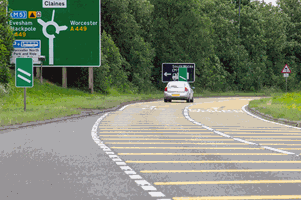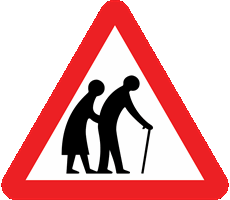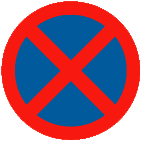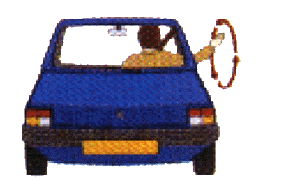You have 57 minutes to answer 50 multiple choice theory test questions. You need to answer at least 43 out of 50 questions correctly to pass. You can review your answer after each question or you can review all of your answers at the end of the test. Best of luck!
Test Quick View
Click on an answer to view the correct choice along with the explanation.
Correct Answer: C
Explanation: These lines are often found on the approach to a roundabout or a dangerous junction. They give you extra warning to adjust your speed. Look well ahead and do this in good time.
Explanation: These lines are often found on the approach to a roundabout or a dangerous junction. They give you extra warning to adjust your speed. Look well ahead and do this in good time.
Correct Answer: C
Explanation: The highest point of the bridge is in the centre so a large vehicle might have to move to the centre of the road to allow it enough room to pass under the bridge.
Explanation: The highest point of the bridge is in the centre so a large vehicle might have to move to the centre of the road to allow it enough room to pass under the bridge.
Correct Answer: A
Explanation: Be aware that older people might take a long time to cross the road. They might also be hard of hearing and not hear you approaching. Don't hurry older people across the road by getting too close to them or revving your engine.
Explanation: Be aware that older people might take a long time to cross the road. They might also be hard of hearing and not hear you approaching. Don't hurry older people across the road by getting too close to them or revving your engine.
4. Which of these IS NOT allowed to travel in the right-hand lane of a three-lane motorway?
Mark one answer
B
C
D
Correct Answer: D
Explanation: A vehicle with a trailer is restricted to 60 mph. For this reason it isn't allowed in the right-hand lane as it might hold up the faster-moving traffic that wishes to overtake in that lane.
Explanation: A vehicle with a trailer is restricted to 60 mph. For this reason it isn't allowed in the right-hand lane as it might hold up the faster-moving traffic that wishes to overtake in that lane.
Correct Answer: A
Explanation: Where you see this sign the 20 mph restriction ends. Check all around for possible hazards and only increase your speed if it's safe to do so.
Explanation: Where you see this sign the 20 mph restriction ends. Check all around for possible hazards and only increase your speed if it's safe to do so.
Correct Answer: A
Explanation: If you intend to stop and rest, this sign allows you time to reduce speed and pull over safely.
Explanation: If you intend to stop and rest, this sign allows you time to reduce speed and pull over safely.
Correct Answer: D
Explanation: As you approach a roundabout look well ahead and check all signs. Decide which exit you wish to take and move into the correct position as you approach the roundabout, signalling as required.
Explanation: As you approach a roundabout look well ahead and check all signs. Decide which exit you wish to take and move into the correct position as you approach the roundabout, signalling as required.
Correct Answer: C
Explanation: These have been put in place to slow the traffic down. They're usually found in residential areas. Slow down to an appropriate speed.
Explanation: These have been put in place to slow the traffic down. They're usually found in residential areas. Slow down to an appropriate speed.
Correct Answer: C
Explanation: Ring roads are designed to relieve congestion in towns and city centres.
Explanation: Ring roads are designed to relieve congestion in towns and city centres.
Correct Answer: D
Explanation: When amber is showing on its own red will appear next. The amber light means STOP, unless you have already crossed the stop line or you are so close to it that pulling up might cause a collision.
Explanation: When amber is showing on its own red will appear next. The amber light means STOP, unless you have already crossed the stop line or you are so close to it that pulling up might cause a collision.
Correct Answer: A
Explanation: On the motorway, signs sometimes show temporary warnings due to traffic or weather conditions. They may be used to indicate
- lane closures,
- temporary speed limits,
- weather warnings.
Explanation: On the motorway, signs sometimes show temporary warnings due to traffic or weather conditions. They may be used to indicate
- lane closures,
- temporary speed limits,
- weather warnings.
12. As you approach a pelican crossing the lights change to green. Elderly people are halfway across. You should
Mark one answer
B
C
D
Correct Answer: C
Explanation: Even if the lights turn to green, wait for them to clear the crossing. Allow them to cross the road in their own time, and don't try to hurry them by revving your engine.
Explanation: Even if the lights turn to green, wait for them to clear the crossing. Allow them to cross the road in their own time, and don't try to hurry them by revving your engine.
Correct Answer: A
Explanation: The sign gives you an early warning of a speed restriction. If you are travelling at a higher speed, slow down in good time. You could come across queuing traffic due to roadworks or a temporary obstruction.
Explanation: The sign gives you an early warning of a speed restriction. If you are travelling at a higher speed, slow down in good time. You could come across queuing traffic due to roadworks or a temporary obstruction.
14. You are on a road that has no traffic signs. There are street lights. What is the speed limit?
Mark one answer
B
C
D
Correct Answer: B
Explanation: If you aren't sure of the speed limit a good indication is the presence of street lights. If there is street lighting the speed limit will be 30 mph unless otherwise indicated.
Explanation: If you aren't sure of the speed limit a good indication is the presence of street lights. If there is street lighting the speed limit will be 30 mph unless otherwise indicated.
Correct Answer: C
Explanation: In some situations drivers may need to give arm signals, in addition to indicators, to make their intentions clear. For arm signals to be effective, all road users should know their meaning.
Explanation: In some situations drivers may need to give arm signals, in addition to indicators, to make their intentions clear. For arm signals to be effective, all road users should know their meaning.
16. You are approaching crossroads. The traffic lights have failed. What should you do?
Mark one answer
B
C
D
Correct Answer: B
Explanation: When approaching a junction where the traffic lights have failed, you should proceed with caution. Treat the situation as an unmarked junction and be prepared to stop.
Explanation: When approaching a junction where the traffic lights have failed, you should proceed with caution. Treat the situation as an unmarked junction and be prepared to stop.
17. You are following a slower-moving vehicle on a narrow country road. There is a junction just ahead on the right. What should you do?
Mark one answer
B
C
D
Correct Answer: D
Explanation: You should never overtake as you approach a junction. If a vehicle emerged from the junction while you were overtaking, a dangerous situation could develop very quickly.
Explanation: You should never overtake as you approach a junction. If a vehicle emerged from the junction while you were overtaking, a dangerous situation could develop very quickly.
18. In very hot weather the road surface can become soft. Which TWO of the following will be most affected?
Mark two answers
B
C
D
Correct Answer: A, C
Explanation: Only a small part of your tyres is in contact with the road. This is why you must consider the surface on which you're travelling, and alter your speed to suit the road conditions.
Explanation: Only a small part of your tyres is in contact with the road. This is why you must consider the surface on which you're travelling, and alter your speed to suit the road conditions.
Correct Answer: A
Explanation: Potholes and bumps in the road can unbalance a motorcyclist. For this reason the rider might swerve to avoid an uneven road surface. Watch out at places where this is likely to occur.
Explanation: Potholes and bumps in the road can unbalance a motorcyclist. For this reason the rider might swerve to avoid an uneven road surface. Watch out at places where this is likely to occur.
B
C
D
Correct Answer: C
Explanation: Print or write down your route before setting out. Some places are not well signed so using place names and road numbers may help you avoid problems en route. Try to get an idea of how far you're going before you leave. You can also use it to re-check the next stage at each rest stop.
Explanation: Print or write down your route before setting out. Some places are not well signed so using place names and road numbers may help you avoid problems en route. Try to get an idea of how far you're going before you leave. You can also use it to re-check the next stage at each rest stop.
Correct Answer: A
Explanation: If possible, avoid the early morning and, late afternoon and early evening 'rush hour'. Doing this should allow you to travel in a more relaxed frame of mind, concentrate solely on what you're doing and arrive at your destination feeling less stressed.
Explanation: If possible, avoid the early morning and, late afternoon and early evening 'rush hour'. Doing this should allow you to travel in a more relaxed frame of mind, concentrate solely on what you're doing and arrive at your destination feeling less stressed.
Correct Answer: A
Explanation: If you are keeping a vehicle, or vehicles, off road and don't want to pay road tax you must declare SORN. You must still do this even if the vehicle is incapable of being used, for example it may be under restoration or being stored. After 12 months you must send another SORN declaration or re-license your vehicle. You will be fined if you don't do this. The SORN will end if you sell the vehicle and the new owner will be responsible immediately.
Explanation: If you are keeping a vehicle, or vehicles, off road and don't want to pay road tax you must declare SORN. You must still do this even if the vehicle is incapable of being used, for example it may be under restoration or being stored. After 12 months you must send another SORN declaration or re-license your vehicle. You will be fined if you don't do this. The SORN will end if you sell the vehicle and the new owner will be responsible immediately.
Correct Answer: C
Explanation: You should be constantly scanning the road for clues about what is going to happen next. Check your mirrors regularly, particularly as soon as you spot a hazard. What is happening behind may affect your response to hazards ahead.
Explanation: You should be constantly scanning the road for clues about what is going to happen next. Check your mirrors regularly, particularly as soon as you spot a hazard. What is happening behind may affect your response to hazards ahead.
24. In heavy motorway traffic the vehicle behind you is following too closely. How can you lower the risk of a collision?
Mark one answer
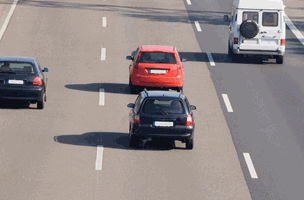
B
C
D
Correct Answer: A
Explanation: On busy roads traffic may still travel at high speeds despite being close together. Don't follow too closely to the vehicle in front. If a driver behind seems to be 'pushing' you, gradually increase your distance from the vehicle in front by slowing down gently. This will give you more space in front if you have to brake, and lessen the risk of a collision involving several vehicles.
Explanation: On busy roads traffic may still travel at high speeds despite being close together. Don't follow too closely to the vehicle in front. If a driver behind seems to be 'pushing' you, gradually increase your distance from the vehicle in front by slowing down gently. This will give you more space in front if you have to brake, and lessen the risk of a collision involving several vehicles.
25. At an incident a casualty is unconscious. Which THREE of these should you check urgently?
Mark three answers
B
C
D
E
Correct Answer: A, B, D
Explanation: Remember DR ABC. An unconscious casualty may have difficulty breathing. Check that their airway is clear by tilting the head back gently and unblock it if necessary. Then make sure they are breathing. If there is bleeding, stem the flow by placing clean material over any wounds but without pressing on any objects in the wound. Compressions may need to be given to maintain circulation.
Explanation: Remember DR ABC. An unconscious casualty may have difficulty breathing. Check that their airway is clear by tilting the head back gently and unblock it if necessary. Then make sure they are breathing. If there is bleeding, stem the flow by placing clean material over any wounds but without pressing on any objects in the wound. Compressions may need to be given to maintain circulation.
26. You have stopped at an incident to give help. Which THREE things should you do?
Mark three answers
B
C
D
E
Correct Answer: B, D, E
Explanation: There are a number of things you can do to help, even without expert training. Be aware of further danger and fire, make sure the area is safe. People may be in shock. Don't give them anything to eat or drink. Keep them warm and comfortable and reassure them. Don't move injured people unless there is a risk of further danger.
Explanation: There are a number of things you can do to help, even without expert training. Be aware of further danger and fire, make sure the area is safe. People may be in shock. Don't give them anything to eat or drink. Keep them warm and comfortable and reassure them. Don't move injured people unless there is a risk of further danger.
B
C
D
Correct Answer: D
Explanation: The motorcyclist is in an extremely vulnerable position, exposed to further danger from traffic. Approaching vehicles need advance warning in order to slow down and safely take avoiding action or stop. Don't put yourself or anyone else at risk. Use the hazard warning lights on your vehicle to alert other road users to the danger.
Explanation: The motorcyclist is in an extremely vulnerable position, exposed to further danger from traffic. Approaching vehicles need advance warning in order to slow down and safely take avoiding action or stop. Don't put yourself or anyone else at risk. Use the hazard warning lights on your vehicle to alert other road users to the danger.
Correct Answer: C, D
Explanation: Unblocking the airway and gently tilting the head back will help the casualty to breathe. They will then be in the correct position if mouth-to-mouth resuscitation is required. Don't move a casualty unless there's further danger.
Explanation: Unblocking the airway and gently tilting the head back will help the casualty to breathe. They will then be in the correct position if mouth-to-mouth resuscitation is required. Don't move a casualty unless there's further danger.
29. You are driving along this road. The red van cuts in close in front of you. What should you do?
Mark one answer
B
C
D
Correct Answer: B
Explanation: There are times when other drivers make incorrect or ill-judged decisions. Be tolerant and try not to retaliate or react aggressively. Always consider the safety of other road users, your passengers and yourself.
Explanation: There are times when other drivers make incorrect or ill-judged decisions. Be tolerant and try not to retaliate or react aggressively. Always consider the safety of other road users, your passengers and yourself.
30. You are driving in traffic at the speed limit for the road. The driver behind is trying to overtake. You should
Mark one answer
B
C
D
Correct Answer: B
Explanation: Keep a steady course to give the driver behind an opportunity to overtake safely. If necessary, slow down. Reacting incorrectly to another driver's impatience can lead to danger.
Explanation: Keep a steady course to give the driver behind an opportunity to overtake safely. If necessary, slow down. Reacting incorrectly to another driver's impatience can lead to danger.
Correct Answer: D
Explanation: Consult the vehicle handbook or garage before driving the vehicle. Only drive to a garage if it is safe to do so. If you're not sure get expert help.
Explanation: Consult the vehicle handbook or garage before driving the vehicle. Only drive to a garage if it is safe to do so. If you're not sure get expert help.
Correct Answer: B
Explanation: Keep calm and don't brake harshly or you could lose control completely. Ease off the accelerator until the unit is brought back under control. The most dangerous time is on long downhill gradients.
Explanation: Keep calm and don't brake harshly or you could lose control completely. Ease off the accelerator until the unit is brought back under control. The most dangerous time is on long downhill gradients.
33. You have been driving in thick fog which has now cleared. You must switch OFF your rear fog lights because
Mark one answer
B
C
D
Correct Answer: A
Explanation: It is essential that the traffic behind is given a clear warning when you brake. In good visibility, your rear fog lights can make it hard for others to see your brake lights. Make sure you switch off your fog lights when the visibility improves.
Explanation: It is essential that the traffic behind is given a clear warning when you brake. In good visibility, your rear fog lights can make it hard for others to see your brake lights. Make sure you switch off your fog lights when the visibility improves.
Correct Answer: B
Explanation: Catalytic converters reduce the harmful gases given out by the engine. The gases are changed by a chemical process as they pass through a special filter.
Explanation: Catalytic converters reduce the harmful gases given out by the engine. The gases are changed by a chemical process as they pass through a special filter.
35. Which of the following types of glasses should NOT be worn when driving at night?
Mark one answer
B
C
D
Correct Answer: D
Explanation: If you are driving at night or in poor visibility, tinted lenses will reduce the efficiency of your vision, by reducing the amount of available light reaching your eyes.
Explanation: If you are driving at night or in poor visibility, tinted lenses will reduce the efficiency of your vision, by reducing the amount of available light reaching your eyes.
Correct Answer: A, B
Explanation: When you purchase your vehicle, check at what intervals you should have it serviced. This can vary depending on model and manufacturer. Use the service manual and keep it up to date. The cost of a service may well be less than the cost of running a poorly maintained vehicle.
Explanation: When you purchase your vehicle, check at what intervals you should have it serviced. This can vary depending on model and manufacturer. Use the service manual and keep it up to date. The cost of a service may well be less than the cost of running a poorly maintained vehicle.
37. What else can seriously affect your concentration, other than alcoholic drinks?
Mark three answers
B
C
D
E
Correct Answer: B, C, E
Explanation: Even a slight distraction can allow your concentration to drift. Maintain full concentration at all times so you stay in full control of your vehicle.
Explanation: Even a slight distraction can allow your concentration to drift. Maintain full concentration at all times so you stay in full control of your vehicle.
38. As a driver you find that your eyesight has become very poor. Your optician says they cannot help you. The law says that you should tell
Mark one answer
B
C
D
Correct Answer: B
Explanation: This will have a serious effect on your judgement and concentration. If you cannot meet the eyesight requirements you must tell DVLA (or DVA in Northern Ireland)
Explanation: This will have a serious effect on your judgement and concentration. If you cannot meet the eyesight requirements you must tell DVLA (or DVA in Northern Ireland)
Correct Answer: B
Explanation: Rear fog lights make it easier to spot a vehicle ahead in foggy conditions. Avoid the temptation to use other vehicles' lights as a guide, as they may give you a false sense of security.
Explanation: Rear fog lights make it easier to spot a vehicle ahead in foggy conditions. Avoid the temptation to use other vehicles' lights as a guide, as they may give you a false sense of security.
Correct Answer: D
Explanation: Always remove the key and lock your car even if you only leave it for a few minutes.
Explanation: Always remove the key and lock your car even if you only leave it for a few minutes.
B
C
D
Correct Answer: A
Explanation: The restraint should be adjusted so that it gives maximum protection to the head and neck. This will help in the event of a rear-end collision.
Explanation: The restraint should be adjusted so that it gives maximum protection to the head and neck. This will help in the event of a rear-end collision.
Correct Answer: D
Explanation: Although carbon dioxide is still produced, a catalytic converter reduces the toxic and polluting gases by up to 90%. Unleaded fuel must be used in vehicles fitted with a catalytic converter.
Explanation: Although carbon dioxide is still produced, a catalytic converter reduces the toxic and polluting gases by up to 90%. Unleaded fuel must be used in vehicles fitted with a catalytic converter.
Correct Answer: A
Explanation: Riding in a towed caravan is highly dangerous. The safety of the entire unit is dependent on the stability of the trailer. Moving passengers would make the caravan unstable and could cause loss of control.
Explanation: Riding in a towed caravan is highly dangerous. The safety of the entire unit is dependent on the stability of the trailer. Moving passengers would make the caravan unstable and could cause loss of control.
44. What is the legal minimum insurance cover you must have to drive on public roads?
Mark one answer
B
C
D
Correct Answer: C
Explanation: The minimum insurance required by law is third party cover. This covers others involved in a collision but not damage to your vehicle. Basic third party insurance won't cover theft or fire damage. Check with your insurance company for advice on the best cover for you and make sure that you read the policy carefully.
Explanation: The minimum insurance required by law is third party cover. This covers others involved in a collision but not damage to your vehicle. Basic third party insurance won't cover theft or fire damage. Check with your insurance company for advice on the best cover for you and make sure that you read the policy carefully.
Correct Answer: C
Explanation: Fitting a stabiliser to your tow bar will help to reduce snaking by the caravan especially where there are crosswinds. However, this does not take away your responsibility to ensure that your vehicle/caravan combination is loaded correctly.
Explanation: Fitting a stabiliser to your tow bar will help to reduce snaking by the caravan especially where there are crosswinds. However, this does not take away your responsibility to ensure that your vehicle/caravan combination is loaded correctly.
Correct Answer: C
Explanation: Coasting, is the term used when the clutch is held down, or the gear lever is in neutral, and the vehicle is allowed to freewheel. This reduces the driver's control of the vehicle. When you coast, the engine can't drive the wheels to pull you through a corner. Coasting also removes the assistance of engine braking that helps to slow the car.
Explanation: Coasting, is the term used when the clutch is held down, or the gear lever is in neutral, and the vehicle is allowed to freewheel. This reduces the driver's control of the vehicle. When you coast, the engine can't drive the wheels to pull you through a corner. Coasting also removes the assistance of engine braking that helps to slow the car.
Correct Answer: C
Explanation: You MUST use dipped headlights and/or fog lights in fog when visibility is seriously reduced to 100 metres (328 feet) or less.You should use dipped headlights, but NOT fog lights, when visibility is poor, such as in heavy rain.
Explanation: You MUST use dipped headlights and/or fog lights in fog when visibility is seriously reduced to 100 metres (328 feet) or less.You should use dipped headlights, but NOT fog lights, when visibility is poor, such as in heavy rain.
Correct Answer: D
Explanation: Too much oil in the engine will create excess pressure and could damage engine seals and cause oil leaks. Any excess oil should be drained off.
Explanation: Too much oil in the engine will create excess pressure and could damage engine seals and cause oil leaks. Any excess oil should be drained off.
B
C
D
Correct Answer: D
Explanation: Usually a correct child restraint MUST be used. In a few exceptional cases if one is not available an adult seat belt MUST be used. In a collision unrestrained objects and people can cause serious injury or even death.
Explanation: Usually a correct child restraint MUST be used. In a few exceptional cases if one is not available an adult seat belt MUST be used. In a collision unrestrained objects and people can cause serious injury or even death.
50. You are leaving your vehicle parked on a road unattended. When may you leave the engine running?
Mark one answer
B
C
D
Correct Answer: C
Explanation: When you leave your vehicle parked on a road, switch off the engine and secure the vehicle. Make sure there aren't any valuables visible, shut all the windows, lock the vehicle, set the alarm if it has one and use an anti-theft device such as a steering wheel lock.
Explanation: When you leave your vehicle parked on a road, switch off the engine and secure the vehicle. Make sure there aren't any valuables visible, shut all the windows, lock the vehicle, set the alarm if it has one and use an anti-theft device such as a steering wheel lock.



